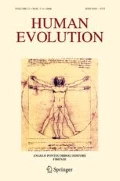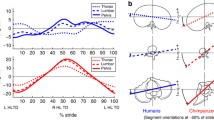Abstract
The human gluteus maximus differs from that of the other hominoids because of its size and bony attachments. These differences raise questions concerning their sequence of appearance in human evolution. Given that humans practice a unique locomotor style, one wonders if the human gluteus maximus morphology is a prerequisite or a consequence of upright bipedal locomotion. This question is addressed using a computer model that evaluates muscle leverage in a variety of locomotor postures. In this model, the human-like, or ape-like, muscular pattern is imposed upon a representative hindlimb of each of the five extant hominoids. Shapes of the skeletal elements (i.e. ilium and ischium lengths) are adjusted in the computer to simulate an evolutionary progression from an ape to a human skeletal morphology. Changes in the leverage of different parts of the gluteus maximus (measured as moment arms) are monitored during this transition. The results show how the mechanical leverages of the gluteus maximus would have changed in a variety of hypothetical evolutionary sequences that describe an ape to human transition.
Although the hominoid models exhibit minor differences in these simulations, they all show that the postural and locomotor functions of the gluteus maximus would become more difficult if musculoskeletal morphology changed to the human-like pattern before erect bipedal posture was adopted. Conversely, small adjustments in the ape-like musculoskeletal condition support an erect bipedal posture. These results suggest that a human like posture would have preceded the appearance of the human-like musculoskeletal morphology. Human gluteal morphology, therefore, is a consequence and not a prerequisite of the upright bipedal posture.
Similar content being viewed by others
References
Aiello, L. C. & Dean, C. (1990). An introduction to human evolutionary anatomy. San Diego, Academic Press.
Basmajian, J. V. & DeLuca, C. J. (1985) Muscles alive: their function revealed by electromyography. 5th edition. Baltimore: Williams & Wilkins.
Greiner, T. M. (1991). The muscular mechanics of the primate hindlimb. (Abstract). Am. J. Phys. Anthropol. Supplement 12, 83.
Greiner, T. M. (1994). Biomechanics of the Primate Hindlimb and the Evolution of Human Locomotion. Ph.D. Dissertation. State University of New York at Binghamton (Binghamton).
Hildebrand, M. (1988) Analysis of vertebrate structure. 3rd edition, New York: John Wiley & Sons, Inc.
Ishida, H., Kumakura, H. & Kondo, S. (1985). Primate bipedalism and quadrupedalism: comparative electromyography. In (S. Kondo, Ed) Primate morphophysiology, locomotor analyses and human bipedalism, pp. 59–80, Tokyo: Tokyo University Press.
Jenkins, F. A. (1972). Chimpanzee bipedalism: cineradiographic analysis and applications. Science 178, 877–879.
Kummer, B. K. F. (1972). Functional adaptation to posture in the pelvis of man and other primates. In (R. H. Tuttle, Ed) Primate functional morphology and evolution, pp. 281–290. The Hague: Mouton Publishers.
Mansour, J. M. & Periera, J. M. (1987) Quantitative functional anatomy of the lower limb with application to human gait. J. Biomech. 20, 51–58.
Marzke, M. W., Longhill, J. M. & Rasmussen, S. A. (1988). Gluteus maximus muscle function and the origin of hominid bipedality. Am. J. Phys. Anthropol. 77, 519–528.
O’Connell, A. L. & Gardner, E. B. (1972). Understanding the scientific bases of human movement. Baltimore: The Williams and Wilkins Co.
Prost, J. H. (1967). Bipedalism of man and gibbon compared using estimates of joint motion. Am. J. Phys. Anthropol. 26, 135–148.
Robinson, J. T., Freedman, L. & Sigmon, B. A. (1972). Some aspects of pongid and hominid bipedality. J. Hum. Evo. 1, 361–369.
Sigmon, B. A. (1975). Functions and evolution of hominid hip and thigh musculature. In (R. H. Tuttle, Ed) Primate functional morphology and evolution, pp. 235–252, The Hague: Mouton Publishers.
Sigmon, B. A. & Farslow, D. L. (1986). The primate hindlimb. In (D. R. Swindler & J. Erwin, Eds) Comparative primate biology, Vol. 1: Systematics, evolution, and anatomy, pp. 671–718, New York: Alan R. Liss.
Stern, J. T. (1972). Anatomical and functional specializations of the human gluteus maximus. Am. J. Phys. Anthropol. 36, 315–340.
Stern, J. T. & Susman, R. L. (1981). Electromyography of the gluteal muscles inHylobates, Pongo, andPan: implications for the evolution of hominid bipedality. Am. J. Phys. Anthropol. 55, 153–166.
Tuttle, R. H., Basmajian, J. V. & Ischida, H. (1975). Electromyography of the gluteus maximus muscle inGorilla and the evolution of hominid bipedalism. In (R. H. Tuttle, Ed) Primate functional morphology and evolution, pp. 251–269. The Hague: Mouton Publishers.
Visser, J. J., Hoogkamer, J. E., Bobbert, M. F. & Huijing, P. A. (1990). Length and moment arm of human leg muscles as a function of knee and hip-joint angles. Eur. J. Appl. Physiol. 61, 453–460.
Williams, P. L., Warwick, R., Dyson, M. & Bannister, L. H. (1989). Gray’s anatomy. 37th Ed. Edinburgh: Churchill Livingstone.
Author information
Authors and Affiliations
Rights and permissions
About this article
Cite this article
Greiner, T.M. The morphology of the gluteus maximus during human evolution: Prerequisite or consequence of the upright bipedal posture?. Hum. Evol. 17, 79–94 (2002). https://doi.org/10.1007/BF02436430
Received:
Accepted:
Issue Date:
DOI: https://doi.org/10.1007/BF02436430




